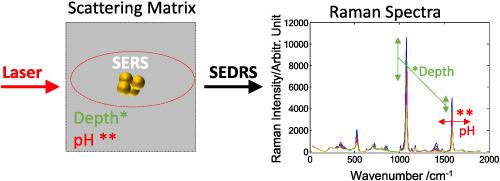当前位置:
X-MOL 学术
›
J. Raman Spectrosc.
›
论文详情
Our official English website, www.x-mol.net, welcomes your feedback! (Note: you will need to create a separate account there.)
Noninvasive simultaneous monitoring of pH and depth using surface‐enhanced deep Raman spectroscopy
Journal of Raman Spectroscopy ( IF 2.5 ) Pub Date : 2020-03-20 , DOI: 10.1002/jrs.5875 Benjamin Gardner 1 , Nicholas Stone 1 , Pavel Matousek 2
Journal of Raman Spectroscopy ( IF 2.5 ) Pub Date : 2020-03-20 , DOI: 10.1002/jrs.5875 Benjamin Gardner 1 , Nicholas Stone 1 , Pavel Matousek 2
Affiliation

|
Here we demonstrate the simultaneous recovery of multiplexed physical information of surface‐enhanced Raman scattering (SERS) nanoparticles (pH and depth) using deep Raman spectroscopy. As has been shown previously and in accordance with theory, inelastically scattered photons arising from spectral peaks that are suitably separated can exhibit different optical properties in the media through which they travel. These differences can impact the relative intensities of the Raman peaks as a function of the transmission path length; thereby, the depth of signal generation is inherently encoded in the spectra; assuming the target is clustered at a single depth or location, its depth can be readily determined. Moreover, Raman spectroscopy is very sensitive to chemistry of a sample, and changes in pH are observed not only as changes in peak intensity through relevant protonation and deprotonation but also as shifts in spectral features. Here, we show it is possible to precisely predict the depth (root‐mean‐square error [RMSE] 5 %) of SERS nanoparticles in scattering media (0.5% intralipid) while also being able to noninvasively monitor simultaneously the pH levels (RMSE ~0.2 pH units) of the media surrounding the nanoparticles. This is important as it demonstrates that nanoparticles can be used to report on multiple physical properties including their depth. This opens avenues for a range of new applications including the noninvasive diagnosis and localisation of cancer lesions in clinical environment in vivo.
中文翻译:

使用表面增强深拉曼光谱仪无创地同时监测pH和深度
在这里,我们演示了使用深拉曼光谱学同时恢复表面增强拉曼散射(SERS)纳米粒子(pH和深度)的多重物理信息的方法。如先前所示并且根据理论,由适当分离的光谱峰产生的非弹性散射光子在其传播的介质中可以表现出不同的光学特性。这些差异会影响拉曼峰的相对强度,这是传输路径长度的函数。因此,信号产生的深度被固有地编码在频谱中。假设目标聚集在单个深度或位置,则可以轻松确定其深度。此外,拉曼光谱对样品的化学非常敏感,pH值的变化不仅表现为通过相关质子化和去质子化引起的峰强度变化,而且还表现为光谱特征的变化。在这里,我们证明了可以精确预测SERS纳米粒子在散射介质(0.5%脂质内)中的深度(均方根误差[RMSE] 5%),同时还能够无创地同时监测pH值(RMSE〜 0.2 pH单位)的纳米颗粒周围的介质。这很重要,因为它证明了纳米颗粒可用于报告多种物理性质,包括其深度。这为一系列新应用开辟了道路,包括在体内临床环境中对癌症病变进行无创诊断和定位。我们表明可以精确预测SERS纳米颗粒在散射介质(0.5%脂质内)中的深度(均方根误差[RMSE] 5%),同时还可以无创地同时监测pH值(RMSE〜0.2 pH)单位)围绕纳米粒子的媒体。这很重要,因为它证明了纳米颗粒可用于报告多种物理性质,包括其深度。这为一系列新应用开辟了道路,包括在体内临床环境中对癌症病变进行无创诊断和定位。我们表明可以精确预测SERS纳米颗粒在散射介质(0.5%脂质内)中的深度(均方根误差[RMSE] 5%),同时还可以无创地同时监测pH值(RMSE〜0.2 pH)单位)围绕纳米粒子的媒体。这很重要,因为它证明了纳米颗粒可用于报告多种物理性质,包括其深度。这为一系列新应用开辟了道路,包括在体内临床环境中对癌症病变进行无创诊断和定位。这很重要,因为它证明了纳米颗粒可用于报告多种物理性质,包括其深度。这为一系列新应用开辟了道路,包括在体内临床环境中对癌症病变进行无创诊断和定位。这很重要,因为它证明了纳米颗粒可用于报告多种物理性质,包括其深度。这为一系列新应用开辟了道路,包括在体内临床环境中对癌症病变进行无创诊断和定位。
更新日期:2020-03-20
中文翻译:

使用表面增强深拉曼光谱仪无创地同时监测pH和深度
在这里,我们演示了使用深拉曼光谱学同时恢复表面增强拉曼散射(SERS)纳米粒子(pH和深度)的多重物理信息的方法。如先前所示并且根据理论,由适当分离的光谱峰产生的非弹性散射光子在其传播的介质中可以表现出不同的光学特性。这些差异会影响拉曼峰的相对强度,这是传输路径长度的函数。因此,信号产生的深度被固有地编码在频谱中。假设目标聚集在单个深度或位置,则可以轻松确定其深度。此外,拉曼光谱对样品的化学非常敏感,pH值的变化不仅表现为通过相关质子化和去质子化引起的峰强度变化,而且还表现为光谱特征的变化。在这里,我们证明了可以精确预测SERS纳米粒子在散射介质(0.5%脂质内)中的深度(均方根误差[RMSE] 5%),同时还能够无创地同时监测pH值(RMSE〜 0.2 pH单位)的纳米颗粒周围的介质。这很重要,因为它证明了纳米颗粒可用于报告多种物理性质,包括其深度。这为一系列新应用开辟了道路,包括在体内临床环境中对癌症病变进行无创诊断和定位。我们表明可以精确预测SERS纳米颗粒在散射介质(0.5%脂质内)中的深度(均方根误差[RMSE] 5%),同时还可以无创地同时监测pH值(RMSE〜0.2 pH)单位)围绕纳米粒子的媒体。这很重要,因为它证明了纳米颗粒可用于报告多种物理性质,包括其深度。这为一系列新应用开辟了道路,包括在体内临床环境中对癌症病变进行无创诊断和定位。我们表明可以精确预测SERS纳米颗粒在散射介质(0.5%脂质内)中的深度(均方根误差[RMSE] 5%),同时还可以无创地同时监测pH值(RMSE〜0.2 pH)单位)围绕纳米粒子的媒体。这很重要,因为它证明了纳米颗粒可用于报告多种物理性质,包括其深度。这为一系列新应用开辟了道路,包括在体内临床环境中对癌症病变进行无创诊断和定位。这很重要,因为它证明了纳米颗粒可用于报告多种物理性质,包括其深度。这为一系列新应用开辟了道路,包括在体内临床环境中对癌症病变进行无创诊断和定位。这很重要,因为它证明了纳米颗粒可用于报告多种物理性质,包括其深度。这为一系列新应用开辟了道路,包括在体内临床环境中对癌症病变进行无创诊断和定位。



























 京公网安备 11010802027423号
京公网安备 11010802027423号